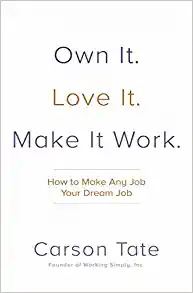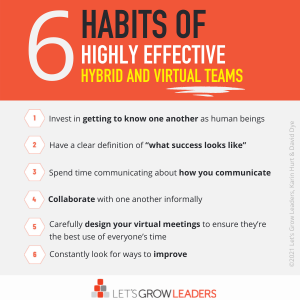David Dye's Blog, page 60
September 3, 2021
Love it. Own it. Your Dream Job with Carson Tate
In this episode, Carson Tate, one of America’s top productivity consultants talks about why you don’t have to rely on your company or your boss for your professional fulfillment. Instead, you can take ownership of your career, your life, and your happiness―right now. Carson’s premise is that “it takes two” to cultivate engagement―that both you and your employer need to have an equal voice in the process. And she outlines five fundamental strategies and tools to make your job work for you and become a dream job.
Your Dream Job(00:43)
Our guest is Carson Tate. She is the founder and managing partner of Working Simply Inc. A business consulting firm that partners with organizations, business leaders, and employees to enhance workplace productivity, foster employee engagement, and build personal and professional legacies, all things we’re fans of here on the show.
(04:09)
Why did Carson want to write this book?
(06:58)
There are two main buckets to look for in job satisfaction. How is your productivity in your role? Do you own it or do you feel overwhelmed and inefficient? Next, examine your purpose. What do your engagement and fulfillment look like? Do you love it?
(10:20)
Then we dive in to discuss how the one person that you’ve got control over is you. Your dream job starts with you.
(11:05)
Now, get clear on how do you want to be seen and acknowledged for your contributions at work. Then learn how each person on your team appreciates being acknowledged. We tend to appreciate people the way we want to be appreciated, and oftentimes that doesn’t work.
(15:00)
As we remember that we get more of what we encourage and celebrate, get to know the encouragement that’s relevant for your people.
(18:27)
Next, we look at aligning your strengths. Get clear on your unique capabilities, skills, and experiences, so that when you do that type of work, it lights you up. It’s energizing. Consequently, you want to do more of it.
(22:41)
Then we discuss how to make our work relationships work? None of us work in isolation. So, how do you cultivate the authentic relationships that create that sense of fun and community at work?
(27:56)
Then we look at how to develop that personal professional development plan, to love and own the direction you’re heading. Carson outlines this plan here as well and gives us where to find several other tools and resources that support this either on her website or LinkedIn.
(29:08)
Next, Carson outlines the steps of the GROW process.
(33:37)
Finally, we discuss the downfalls to having a fixed mindset as a leader, and many advantages to opening up to an expanding mindset.
Get the book
 Connect with Carson
Connect with Carson
The post Love it. Own it. Your Dream Job with Carson Tate appeared first on Let's Grow Leaders.
August 30, 2021
How to Be a Human-Centered Leader when You’re Stressed, Anxious, or Freaked-Out
Many people find it easier to be a human-centered leader when everything’s going well. But when you’re stressed and anxious, it’s easy to snap at your team, lose your temper, and undermine the culture you’ve worked so hard to build. If you have too many of these freak-out moments, your people will conclude that kindness is only for the easy times. Stress and anxiety are unavoidable, but you can lead through these times to build a stronger and more productive team.
5 Steps to be a Human-Centered Leader When You’re StressedRecognizeRememberReassessReconnectRespondIt HappensKarin and I are no strangers to the stress and anxiety that come with leadership. One time my organization faced significant financial stress and I was under pressure to deliver results that felt unrealistic. After three weeks of this stress, two of my department heads came to me and said, “You’re not David anymore. What’s going on? How can we help?” Apparently, I’d become terse, overly directive, wasn’t listening to feedback, and was snapping at people.
Karin shared a similar moment where she had a tough couple of weeks. A cocktail of challenges had affected her team’s normally high performance. They needed strong results immediately. She didn’t realize how much her stress showed on the outside until a trusted manager on her team called her and said bluntly, “You’re changing.” Her normally supportive style had morphed into frantic control. A second manager followed up to say, “Your style works. Stay the course. We believe in you, in us, and the mission. Every one of us has your back. Just tell us what you need.”
It happens. Despite your plans, investment in people, and hard work, there are always times of stress. Circumstances change. Emergencies happen. An unforeseen ball is dropped. What now?
Karin and I were fortunate in these two situations. Our direct reports displayed incredible courage and compassion–for us. They chose the human-centered leadership that we’d let our stress undermine. They gave us an opportunity to course-correct.
(Something to remember the next time your manager is stressed and not leading the way you would hope. In those moments, you have an opportunity to lead up.)
Five Steps to Be a Human-Centered Leader Through Stress and Anxiety1. Recognize what’s happening.The meeting didn’t go well. The numbers didn’t come in the way you hoped. Your team member made a mistake. A competitor did something you never expected. One of your key partners just pulled out.
What do you feel? A tightness in your chest. Heat in your skin. A thin sheen of sweat. That’s your body acting like it’s under attack. It fires up the response systems before we know it. If you don’t recognize what’s happening those stress responses will short-circuit your human-centered leadership.
To maintain your human-centered leadership and reinforce the culture you’ve built, start by taking a few moments to acknowledge what’s happening. “My body is stressed. I’m feeling anxious. I’m worried about what’s going to happen to me, to my team, to this account.”
When you acknowledge your feelings and the stress response, it lessens their grip. You are less likely to snap at a team member when you are aware of your emotions.
(For more on how to check in with yourself and recognize what’s happening, listen to Mastery Under Pressure expert Tina Greenbaum on the Leadership without Losing Your Soul Podcast.)
2. Remember your why.Once you’re aware of what’s happening in your body and how you’re feeling, it’s time to check back in with your purpose. There’s a temptation in stressful moments to react–to do something, anything. But these reactive moments often do more harm than good because they aren’t connected to your purpose.
You’re not doing the work to get the numbers, the promotion, be the best, or look good to your neighbors (even though these are often the sources of our stress and anxiety). You do this work to make a difference to the people you serve. Your customers, clients, and team.
Get back to your big why. In this moment of stress, what is the difference you and your team make? How can you focus on making that difference right now?
3. Reassess what’s happening and your resources.Now that you’ve acknowledged how you’re feeling and are connected back to your purpose, you’re likely feeling more grounded. You’re ready to take productive action.
This is the time to take a hard look at the facts. As you list the facts of the situation, examine them to make sure they are objective, observable reality and not your interpretation or fear. For example, “We’re getting crushed” is an interpretation. While “Our core offering is down 3% and our chief competitor is up 2%” is factual.
The next assessment involves risks and probabilities. What is at stake–again, factually? Try not to catastrophize–what will truly happen because of the situation you’re in? How big is the problem? What’s at stake if it’s not resolved? What are the probabilities of the worst coming to pass? What happens positively if you resolve it?
Once you’ve got a clear picture of the situation and the range of consequences, take a look at your assets. What resources can you bring together to address the issue? You often have many more assets available to help than you first think.

(For more on taking stock of all your assets and overcoming adversity, check out retired Navy Seal Jason Redman’s episode of Leadership without Losing Your Soul.)
4. Reconnect with your team.Speaking of assets, for any human-centered leader, one of your best assets is your team. Our teams brought Karin and me back to our human-centered leadership standards. Your team can help you solve the problem if you bring them in well. Give them the facts. What’s happening? What’s at stake? Give them all the information they need to understand the issue clearly. Describe what a successful solution will accomplish. What will success look like?
Depending on the situation, you can then ask for ideas or where people can help or delegate. Engage your team. Bring them in and help them understand what needs to happen. You don’t need to suffer or muscle through the problem on your own. Your people can surprise you with their ingenuity and effort if you give them the chance.
5. Respond.You’ve centered yourself, connected back to your purpose, taken a clear look at the situation, and engaged your team. Now, it’s time to move. What’s your path forward? Take that next step clearly and confidently. If you get more information that changes your direction, that’s okay. (It’s okay to change your mind–just do it clearly and communicate the reasons.)
Your TurnEven the most human-centered leader will feel stress and anxiety. When you feel that tension start to grip you, know that the human most in need of your leadership at that moment–is you.
I’d love to hear from you–what is your favorite way to maintain healthy and productive leadership when you start to feel the freakout?
The post How to Be a Human-Centered Leader when You’re Stressed, Anxious, or Freaked-Out appeared first on Let's Grow Leaders.
August 27, 2021
Fiercely Loyal with Dov Baron
The world has changed, and so has everything we know about becoming and remaining an effective leader particularly when it comes to keeping your top talent! The effective leaders of tomorrow will do one thing: keep their top talent. In this episode, Dov Baron lays out the strategies for not only keeping your top talent but how to have them become Fiercely Loyal. There are no tricks and not shortcuts – but Dov gives you the fundamentals of human relationships that will drive retention, productivity, and connected teams that achieve amazing results together.
Fiercely Loyal(06:17)
Ask yourself the question, is what I’m doing in alignment with my soul so that we’re not sacrificing our humanity along the way.
(10:03)
Part of the problem in leadership is we don’t give ourselves a chance to emotionally mature because we want to be right. Emotional maturity in our leadership is responsibility. It’s taking responsibility for ourselves, for our own development, for our growth, for where we are today.
(18:41)
We discuss how to find humanity in one another (and ourselves. Then we discuss how to engage the soul of the people in your workplace that joins them?
(21:41)
Next, an important aspect of leadership, listening with curiosity.
(30:52)
Then, we look at how to generate retention and fiercely loyal team members
(33:45)
What does courage look like? Courage is that leaders must go first. For instance, you can’t wait for others to be vulnerable. You have to lead that way.
(38:24)
Whatever values we’re trying to build in the world, organizationally, are we taking responsibility for the expression of those ourselves and then in our teams?
(45:34)
And lastly, how do I help my team connect with the contribution that we are helping people to find that energy and connection?
Connect with Dov
Website
Facebook
Instagram
Twitter
LinkedIn
Youtube
The post Fiercely Loyal with Dov Baron appeared first on Let's Grow Leaders.
August 23, 2021
How to Calculate ROI of Remote vs. In-Person Work? (How to Video)
Your finance team did a bit of quick math to calculate ROI for making the transition to remote teams permanent based on real-estate savings and reduced commute times. But, you know it’s more complicated than that.
So how do you take a more comprehensive approach to measure the ROI?
Beyond the Past PivotIf you’re like so many of our clients, the pandemic caused you to pivot fast to remote work and virtual teams.
You’ve got a long list of pros and cons and anecdotal ROI calculations.
Some employees love it.
Some hate it.
Managers and employees are telling you they’re way more productive. And others can’t wait to get back in the office for a more focused work environment.
So where do you start? How do you truly measure the ROI of remote vs. in-person work?
In this episode of Asking For a Friend, I talk with Jack Phillips, author of High-Impact Human Capital Strategy and Chairman of ROI Institute about how to calculate ROI for remote work vs. in-person work.
Karin Hurt Talks with Jack Phillips About a Strategic Approach to Calculate ROI

1:30 More details about Jack Phillip’s approach to calculating ROI.
2:55 A case study published by SHRM of an insurance company that allowed claims processors and claims examiners to work from home (before the pandemic.)
3:40 Companies are asking how to know what is better for the company and the employees now that there is a choice in the work location. (Office, home, hybrid)
4:16 What are key areas to look at to calculate ROI of remote work?4:20 Reaction: How do people (employees and managers) see this situation?5:08 Learning: the rules for working at home and how to work remotely, measuring by self-assessments, quizzing, or observation.6:27 Application: is it working? Are we following processes? Are we able to manage well?7:20 Impact: What are tangible measures (to covert to money, i.e. savings in office expense), retention levels, and productivity levels. Are there fewer distractions, less stress, and more effort expended to help guarantee the remote option continues? Other items to consider are a reduction in absenteeism and sick days.9:20 What are intangible measures such as lower stress, convenience, money savings for employees?
10:15 Karin: Have all of your studies shown that remote work results in higher ROI? Jack: so far, yes.
11:40 Karin: Are there any downsides?
12:00 Jack: Yes. Teamwork, collaboration, and engagement can go down. Mental health issues because of isolation can increase. Career issues may occur. Knowing these in advance helps you manage these possibilities.
13:58 There are distractions from home as well (i.e. pets, kids, etc) that a company will need to address (particularly if schools go remote, etc.) Policies during the pandemic may not be how they need to run their remote work all the time.
16:20 A discussion of the case study occurring prior to the pandemic.
17:20 The manager makes a key difference.
17:48 There is the possibility of resistance from managers because some are under the impression they have to see workers. There is also an insecurity that their jobs may not be needed.
19:29 For your organization: get a study of the ROI of remote work that includes 1) ROI for executives (make it a credible analysis) 2) ROI from employees through intangibles/viewpoints and 3) help to the environment as that is often a value that companies want to embrace. Profits, people, planet.
23:06 More about the case study. Even with expenses that the company incurred to set people up at home (buildout, technology), the company saw a positive ROI.
26:04 Karin: How do you calculate ROI when it comes to innovation?26:24 Jack: Work from home can get in the way of engagement. The more engaged, the more innovation. Companies need a foundation that encourages innovation to begin with, whether or not they have remote workers.
27:54 Last bit of advice: it takes effort but it doesn’t too take long to collect the right type of data to help you determine the ROI of remote work for your company. Review the case study. Be proactive and do something.
Your turn. What would you add? How are you calculating ROI for your move to virtual and hybrid teams?
The post How to Calculate ROI of Remote vs. In-Person Work? (How to Video) appeared first on Let's Grow Leaders.
How Do I Gain Respect When My Team Doesn’t Like Me?
Of course, leadership is not about being liked. But it sucks to go to work every day when you know your team would rather be working for someone else. Plus, if your team doesn’t respect you, you’re not going to have the influence you need to make an impact. So, how do you gain respect, when your team’s just not there?
This challenging and poignant question came up in one of our “Asking For a Friend” segments following a recent keynote.
“What do I do if I’m sure my team doesn’t like me? How do I gain their respect?”My first response was, “It depends. Why don’t they like you?”
I’m thinking about the handful of managers I had over the years who were the epitome of a jerk at work — the bullies who crush courage with their toxic leadership behaviors or who seem to be lacking a moral compass.
Those folks had deeper issues going on and probably needed a therapist more than an executive coach.
This article is not for them, but for you, the well-intentioned, human-centered leader looking to gain the respect of their team.
3 Reasons Your Team Might Not Like You (and How to Gain Respect)Here are three common reasons you could be losing influence (and what to do to regain respect and the impact you need).
1. Your behavior is sabotaging your leadership influence.We all have blind spots and opportunities to improve our leadership and gain respect. If you sense your team doesn’t like you, start by talking with each member of the team one-on-one.
In Courageous Cultures, I share a story of a well-intentioned manager who was coming across as a bully. Thankfully, one of his team members had the guts to confront him.
What he did next made all the difference. He asked others about their perceptions, and as it turned out, his reputation was consistent.
He learned to change his tone of voice. To ask more questions. And, to enter the room more gently. Those slight modifications to his behavior, coupled with the fact that he was asking for feedback with a real intent to listen, made all the difference. He gained the respect of his team.
In our leadership development programs, we often encourage managers to complete a Do It Yourself 360 (Listening Tour), to gather this feedback. Identifying one or two areas where you really want feedback, and then going out and asking people a few questions, and summarizing the themes.
Managers tell us that this simple process is a great way to get candid feedback to improve their leadership, and it also reinforces that they really are open to change, so it lays the groundwork for psychological safety. and helps them to gain respect. They are easier to approach the next time.
2. They underestimate the value you bring.There was one time in my career where I was absolutely certain that my team didn’t like me.
I had been promoted to lead a 2200 person retail sales team at Verizon. The problem was I had zero sales experience. Thirteen out of fourteen of my direct reports were men. And, fourteen out of fourteen had been in retail sales for their entire careers.
The Associate Director of Operations on the team, “Greg” was an absolute rock star and was the obvious successor for that role. No one on the team could believe that this “HR chick” had been “given” this job. “It was probably a diversity move.”
You can read more about how this story ends in Chapter 6 of Courageous Cultures (you can download the first few chapters of Courageous Cultures for free here).
But here’s the long story short. I showed up in the stores on Sundays (and other times no one wanted to be at work) and rolled up my sleeves to really get to know the team and their approach.
I asked lots of questions and really listened. And then, I showed up with the confidence to establish a strong vision and leverage the skills that had helped me earn that role—rallying a large team to execute a turnaround plan on their most important priorities.
The team won the President’s Award for customer growth that year. One important way to gain the respect of your team is to help them win.
3. You’re holding them accountable for the very first time (stay the course!)Of course, it can be quite a shocker to an underperforming team, when a new manager comes in and holds them accountable for the very first time.
If you sense that your team doesn’t like you because you’ve raised the bar, or are holding them accountable to meet expectations, check your style. Make sure you’re focused on both results AND relationships as you’re giving performance feedback) and then stay the course.
It might be rocky for a minute, but most people really do want to work on a winning team. You might lose a few slackers who will continue to think you’re a jerk, but you will build respect with the rest of your team, not to mention getting the results you need.
Leadership is not about being liked. But, respect matters, if you want to have influence and impact. It starts with understanding where the breakdown is happening and then building a deliberate plan to gain their respect.
Your turn.What would you add?
What’s your best advice to gain respect when your team doesn’t like you?
The post How Do I Gain Respect When My Team Doesn’t Like Me? appeared first on Let's Grow Leaders.
August 21, 2021
How To Speak Up in Meetings (A Video For if You’re Feeling Unsure)
“Hey Karin, I just had my 360 Feedback review, and I heard I should speak up more in meetings. But it’s hard. How do I get better at this?” #AskingForaFriend
4 Ways to Speak Up More in MeetingsThis question came in from a really good friend of mine, whom I’ve known for over 30 years. And here’s the thing. She’s so smart with so much to offer. And, sometimes she holds back and doesn’t speak up in meetings. Which is tragic.
So here’s my advice for her and for anyone struggling to speak up more in meetings.
1. Start Before the Meeting BeginsThe best way to have more confidence and speak up more in meetings is to be really prepared. Ask for the agenda in advance. Or, inquire about the topics to be discussed and decisions to be made.
A little advanced notice about the conversation gives some time to gather your thoughts and prepare your point of view.
2. Imagine the Players at the TableBefore the meeting, picture who will be in the meeting and what could be on their hearts and minds.
Anticipating other people’s contributions and ideas can help you be more prepared to jump into the dialogue and add value.
3. Consider your Most Important Points and Write Them Down in AdvanceIt’s easy for conversations to go all over the place in meetings, particularly if you’re in a team full of extraverts.
Try writing down your most important points in advance, so when the conversation goes sideways, it’s easier to bring the conversation back and speak up more in meetings.
“One idea I ha ve that I want to ensure we consider before we close is _______”
ve that I want to ensure we consider before we close is _______”
Or, you can frame it as a question.
“In preparing for this meeting, I’ve been wondering if we might consider ____. Would that be a topic worth spending a few minutes on?”
4. Position Your Ideas Using our Courageous Cultures I.D.E.A. ModelIf you’ve read Courageous Cultures, attended one of our leadership development programs, or have hung out much on this blog, you know we’re big fans of the I.D.E.A. method for positioning your ideas. This is a great approach to help you speak up in meetings as well.
You can read more about the I.D.E.A approach for positioning your ideas here (or simply watch the video).
Your turn. What are your best practices for speaking up in meetings?
The post How To Speak Up in Meetings (A Video For if You’re Feeling Unsure) appeared first on Let's Grow Leaders.
August 20, 2021
Leading for Justice with Rita Sever
When your cause is important and you’re working to build a better world, leadership matters more than ever – but it often takes a back seat to the scramble to achieve today’s results. The unfortunate consequence in many mission-driven organizations is a toxic or hypocritical culture that doesn’t embrace the same values the organization works to build. This leadership paradox isn’t limited to nonprofit or social justice organizations. The same thing can happen in mission-driven companies. In this episode, Rita Sever gives you practical tools you can use to ensure you are living out your human-centered leadership values while also pursuing the valuable mission your organization exists to achieve.
Leading for Justice1:45 – First, the principles of leading in nonprofits apply to leading other organizations.
6:36 – Then we look at the toxic cultures often produced by mission-motivated leaders who say “if you really cared, you would…”
9:30 – Next, we discuss the three most valuable questions that can keep you and your team on track (and every organization). Why, where, and how are you going?
14:22 – Then, Rita shares how leading for justice requires you to speak and listen without judgment.
15:26 – How to start your accountability conversations to maintain relationships and set a connected, “I’m on your side” atmosphere.
17:30 – Next we discuss equity. What it means, what it looks like, and how leaders skillfully apply consistency to achieve an equitable organization.
20:36 – Now we turn our attention to the massive power (for good and ill) you have. How do you take responsibility for the power you have?
25:37 – Then we talk about being aware of how socialization has created imbalanced communication norms with men and how to take responsibility for building teams where voices have equal weight.
28:38 – Next, Rita shares a practical way you can build a culture where everyone contributes.
Aligning Words and Actions29:59 – How to align your good intentions and good words, with the behaviors that will serve those intentions and resonate with your team.
31:46 – Now we look at the value of listening and thanking people for what they’ve said. How to respond when you’re instinct is to defend yourself.
34:18 – Next, we discuss how leading for justice requires you to be comfortable with discomfort. Ambiguity and discomfort are a key part of the journey.
35:58 – Then we look at pencil culture vs pen culture. How approaching your work and decisions with a “let’s see how this works” perspective builds loyalty and engagement.
39:38 – Next, the role of self-awareness in building more equitable teams and organizations. How leaders can take practical next steps to disrupt some of the ineffective dominant practices that permeate many organizations.
46:11 – Finally, why leaders should dance their way through their work and invite their team to dance with them.
Get Rita’s Book Connect with Rita
Connect with Rita
Website
Facebook
Instagram
Twitter
LinkedIn
Goodreads
The post Leading for Justice with Rita Sever appeared first on Let's Grow Leaders.
August 16, 2021
Overcome the Great Resignation: How Great Leaders Put People Before Projects
When you hear stats like 4 million Americans resigned their roles in one month or that 40% are considering a change in job, you might feel nervous about the future of work, and how the heck you build a culture of sustained performance in all that turmoil. The pandemic has certainly created upheaval and transformed work. If you feel anxious about the future, you’re not alone. Leaders across industries face challenges posed by the remote work revolution, varying degrees of workforce risk tolerance, and seismic disruptions if the Great Resignation hits their team. The good news is that the fundamentals of fostering employee connection and loyalty may look different, but the principles haven’t changed.
7 Ways to Protect Against the Great ResignationConnectCareConsultCultivate CuriosityContributeCommunicateCommitTales from the Great ResignationRecently we spoke with “John,” a C-Suite executive at a national organization, who had just added his name to the list of those leaving their company during the Great Resignation. He was the last of ten other senior leaders who had resigned over the prior six months.
The CEO and Board Chair had looked at the ten previous resignation letters and, seeing the similarities in complaints about toxic culture, concluded that those ten executives must have “had a letter-writing party” to craft such similar messages. Although clearly frustrated, they attributed the turnover to another COVID casualty.
That’s when John knew there was no hope for transforming the organization’s culture and wrote his own letter.
Another Chance to Build Culture“Karl,” a CEO we spoke with that same day, related the story of a recent in-person meeting for his national leadership team, their first face-to-face meeting in two years.
Two hours before the first day started, we received word that one of our newer team members had passed away. She’d only been with us for two months, but many of the leaders there had interacted with her and people liked her. I postponed our agenda that morning. We replaced it with a short announcement, an opportunity for people to share their thoughts and memories.
We happened to have a chaplain in attendance, so I asked her to say some words as well. Then we took an extended break to allow people to process, grieve, talk with one another, and write cards to her family.
During the break, one of our Board of Directors, a retired CEO herself, approached me and said, “Karl, don’t you think we should move this along? I mean, quite a few folks here have never even met her.”
It was a great opportunity to talk with my Board Member about culture. For every person there, whether they knew the woman who passed or not … they knew that how we valued her would be how we valued them. We sacrificed two hours of agenda, but nothing in those agenda items would have done as much for our team.
John and Karl’s organizations are in the same industry and share the same pandemic environment. Their employee retention and engagement, however, are miles apart.
Leading People So They Want to Stick AroundAs the pandemic and uncertainty persist, we invite you to consider putting people before projects. Your connection to your people and their certainty that you care about them are more important than ever.
We’re not saying people instead of projects. It’s people, then projects. The people, then the work. There’s no greater loyalty than the person who can say “My boss is a real human being who knows me, cares about my success, and brings out the best in me and my team.” A team full of those people is hard to beat. Here are seven ways to build that connectivity:
1. Connect–as human beings.Connection begins by being a leader people can connect with. That means sharing appropriate vulnerability and investing in conversations beyond the work from time to time. And, almost nothing builds connection faster in these conversations than truly hearing and seeing the other person. One of the most effective ways to do this is to reflect to connect. When someone shares an experience, joy, or frustration, take a moment to reflect on what you’ve heard or seen back to them.
2. Care–about the whole person.For us, one of the most touching moments of this pandemic was an intense, high-urgency sales leader who looked at his leadership team and told them, “We’ve got to focus on our people. How are they? Who’s hurting? How can we help them?” Whatever else might happen, his team knows he cares–not just about their results (he does), but about them as people.
As you get to know people, learn about their people, pets, and projects. What matters to them outside of work? How can you express interest in these things from time to time?
3. Consult–your people.Hopefully, you aren’t making decisions in isolation. But look for opportunities to bring in people beyond the usual decision-makers. When you describe the problem or challenge you face and invite people into the discussion, two things happen. First, people feel valued–you’ve recognized they have something to contribute. The second benefit is that they have perspectives you can’t have because their work and experience are different from yours. You’ll make better decisions.
4. Cultivate Curiosity–for innovations, improvements, and efficiencies.In addition to consulting your folks for solutions to problems, wise leaders ask courageous questions to uncover micro-innovations and opportunities to improve workflow, customer service, and other business enhancements. Often, people don’t know they have a valuable insight to offer until they’re asked. For them, it’s “just what they do.”
5. Contribute–to people’s growth.Most people appreciate opportunities to grow. Growth and development don’t necessarily mean upward movement into management or leadership roles. There are many ways you can help your people expand their capacity. Opportunities for growth include skill training, different responsibilities, and more interesting or challenging work.
You don’t need to do all the development work for your people. You can use tools like our Developmental Discussion Planner to help employees take responsibility and partner with you for their development.
6. Communicate–consistently.Communication is vital to every relationship, but it’s easy to take it for granted. You might think everyone’s sick of you communicating that key initiative, but they’re probably just beginning to internalize it. You can use our 5×5 Communication strategy to plan your key messages. These should include what’s important, what’s changing, and what’s staying the same. And one of the most important items you can communicate is why all of these are true.
7. Commit–to accountability and performance.It may feel counterintuitive, but high-performing team members value accountability. They want to achieve results and be part of a team where everyone pulls together and contributes their best. When you let slackers slide, you’re telling your top performers that you don’t value their effort or contribution. Help everyone on the team keep their commitments to one another to improve morale and productivity.
Your TurnThe Great Resignation is not a foregone conclusion. While the pandemic has disrupted how many of us work, the fundamentals of leadership haven’t changed. Show up with confidence and humility. Focus on results and relationships.
We’d love to hear from you: What are some of the best instances of connected, human-centered leadership you’ve seen over the past 18 months?
The post Overcome the Great Resignation: How Great Leaders Put People Before Projects appeared first on Let's Grow Leaders.
August 13, 2021
Best Practices of High Performing Virtual Teams (Video)
In this week’s Asking For a Friend, I share best practices I see continually being performed by high-performing virtual teams.
Highlights from the Building High-Performing Virtual Teams Conversation 0:54 High-performing teams invest in the people they are working with as genuine human beings. They’re deliberate about making a human connection and learning about one another.
0:54 High-performing teams invest in the people they are working with as genuine human beings. They’re deliberate about making a human connection and learning about one another.
1:20 They have a clear definition of what success looks like. Team members work hard to align their most important strategic priorities and discuss when these priorities conflict. They have clearly defined strategic initiatives that support these priorities, as well as know the daily behaviors necessary to achieve them.
1:47 They spend time communicating about how they communicate– and have a cadence of great one-on-one meetings.
Also, they don’t wait on the manager to initiate the communication. Team members reach out and collaborate with one another without waiting for an invitation to do so.
2:30 These teams design team meetings to be truly inclusive– and check-in with one another to talk about how the meetings are working.
3:23 And most importantly, they are constantly looking for ways to improve.
Your turn.
What are some of the consistent habits that you see from high-performing virtual teams?
Looking For More Team Building Resources?Don’t miss our more detailed article on leading hybrid and virtual teams or our virtual teams’ assessment.
And you can learn more about our live-online leadership training here.
The post Best Practices of High Performing Virtual Teams (Video) appeared first on Let's Grow Leaders.
How Leaders Make The Most of Complaints
You’ve got a clear focus on what matters most, and your team seems to work well together, but then you get a call. Hey, I need to talk to you about a conflict, a disagreement, a clash of personalities. What you do next will reinforce your leadership and influence or erode your credibility.
Team conflict can feel like quicksand and a distraction from your work, but it can also be an excellent opportunity for your team to grow. In this episode, learn the six steps that you can take to address conflict, effectively build healthy professional relationships and ultimately help your team maintain focus on what matters most.
How Leaders Make the Most of Complaints(03:30)
So how do you address team conflict productively and make the most of complaints? Well, there are six steps that you can take to address it, effectively build healthy professional relationships and ultimately help your team maintain their focus on what matters most. The first thing you want to do is reflect to connect.
(04:48)
Next, step number two is to gather information specifically using three quick questions.
(06:16)
Step three is to diagnose the situation. Figure out if this is an event or is it a problem that needs to be solved. Or is this one of the common types of team conflict?
(07:17)
Once the situation is diagnosed, move to step four which is to choose an appropriate solution.
(09:12)
After the solution is chosen, step five is to schedule the finish and determine what the next steps are for you and the people involved.
(09:57)
The sixth step to make the most of complaints is one of the most effective ways to help your team resolve conflict. Give your team the tools to have meaningful conversations with one another and the expectation that they will use them. The highest-performing teams aren’t shying away from conflict. High-performing teams have conflicts, and they embrace them. They understand that every disagreement is an opportunity to build relationships, improve results and that the conflicts aren’t always about them.
(10:25)
One of the most important tools you can give people to build this skill is the I N S P I R E method for tough conversations that I’ve shared in many episodes in the past. It’s a balanced approach to help your team members build their relationships while achieving results. You can find it by searching on our website.
(11:44)
Lastly, we have several follow-up questions from last week’s episode with Juliet Funt regarding a minute to think.
The post How Leaders Make The Most of Complaints appeared first on Let's Grow Leaders.






